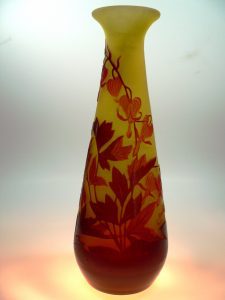Jugendstil-Vase – Deutsch/German

Um die Wende vom 19. zum 20. Jahrhundert begegnen wir in der Kunst dem Jugendstil. Das Glas des Jugendstils lehnt die Nachahmung historischer Stile ab und wird zum künstlerischen Gegenpol der Glasmanufakturen. Einer der wichtigsten Protagonisten der europäischen Glaskunst des Jugendstils war der in Nancy in Frankreich lebende Kunsthandwerker, Botaniker, Chemiker und Fabrikant Emile Gallé. Von ihm stammt die gelbe Vase mit dem rotbraunen Pflanzendekor „Tränende Herzen“.
Seine Motive fand Gallé in der Natur. Für deren Beachtung trat er ein, weil er sie durch die Industrialisierung gefährdet sah. Aber auch der Orient und die Literatur waren für ihn wichtige Inspirationsquellen. In Sachen Glasveredelung und Glasherstellung war Gallé höchst experimentierfreudig – und das, obwohl er selbst nie am Glasofen tätig war. Seine Entwürfe ließ er zunächst als Emailmalerei und Glasschnitt auf das Glas übertragen. Später ging er zu Ätzung, Einschmelzungen und Applikationen über. Die Vase des Glasmuseums hat Gallé um 1900 mittels Ätztechnik hergestellt.
Die Vase war ein Geschenk des Stifters und Sammlers von Jugendstil-Gläsern Henri Veill aus dem französischen Clermont-Ferrand, dessen Schwester in Wertheim wohnt. Die Schenkung war ein großes Glück, denn kurze Zeit später zerstörte ein Wohnungsbrand Veills gesamte Sammlung.
Art Nouveau Vase – English

At the turn of the 19th and 20th centuries we come across Jugendstil, or Art Nouveau. Glass made in this style rejected the imitation of historical styles and became the artistic antithesis of glass manufacturers. One of the most important protagonists of European art nouveau-style glass art was a craftsman, botanist, chemist and factory owner who lived in Nancy in France: Emile Gallé. And he made the yellow vase with red-brown plant decoration entitled „Bleeding Heart.“
Gallé found his motifs in nature and he stuck his neck out for them because he could see they were endangered by industrialisation. But the Orient and literature were all so important sources of inspiration for him and Gallé was more than happy to try out new things in glass production and finishing – even though he never worked at the glass furnace himself! To begin with his designs were applied to the glass using enamel or cut glass, but he later turned to etching, melting and appliqué. Gallé produced the glass in front of you in around 1900 using the etching technique.
This vase was a gift from the sponsor and collector of Art Nouveau glass, Henri Veill from Clermont-Ferrand in France, whose sister lives here in Wertheim. And the donation of it turned out to be a stroke of luck, because shortly afterwards Veill’s collection was completely destroyed in a house fire.